Drawings below are first made from photographs that are then compared with the preserved squid under a microscope. A small error will occur in identifying the two classes of photophores (red - counterilluminating photophores with red color filters = "complex photophores, and blue - simple photophores plus lens bearing photophores = "simple photophores." Blue photophores cannot, yet, be reliably separated, in preserved squid, into the two component types.). A damaged or developing/transforming photophore cannot always be reliably identified. Even the presence or absence of photophores can be difficult on strongly curved surfaces, for example, the sides of the head or mantle when viewed ventrally. Therefore, the photophore arrangement is most accurate on the ventral surfaces when viewed ventrally and on the lateral surfaces when viewed laterally.

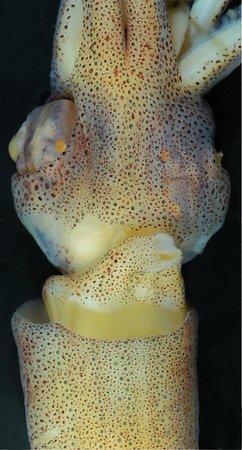
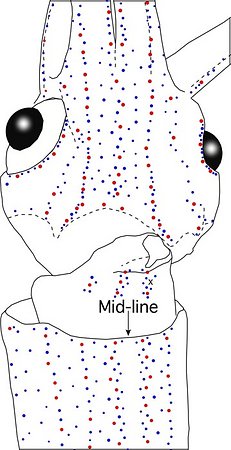
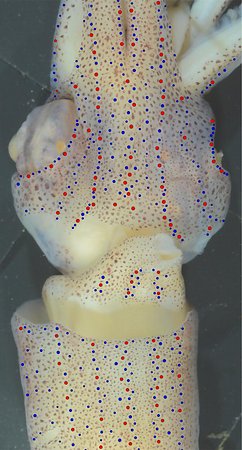
Figure. Ventral views of the integumental photophores of Abraliopsis sp. NC1, female, 26 mm ML, off New Caledonia. Left - Photograph of the preserved squid. Middle - Outline drawing from photograph with all integumental photophores represented by colored dots. Right - Photograph (dimmed) with superimposed dots on integumental photophores. Red dots - Complex photophores. Blue dots - Non-complex photophores. Images by R. Young.

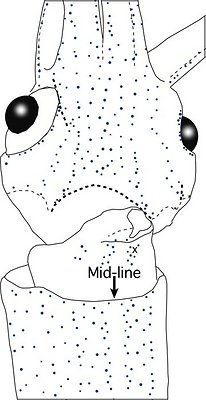
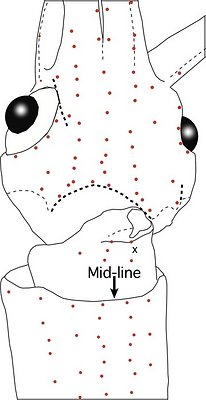
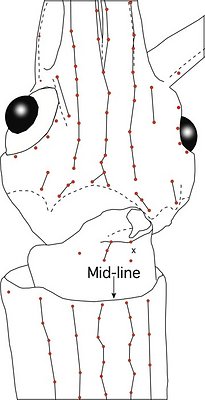
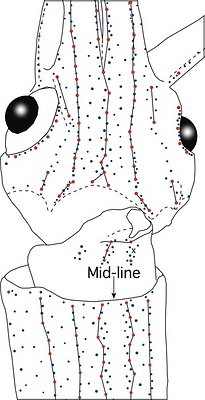
Figure. Same squid, same view as above. Left - Drawing showing only the non-complex (blue) photophores. Left middle - Drawing showing only the complex (red) photophores. Right middle - Same as previous drawing with lines connecting red photophores to aid comparisons of photophore patterns between species. Right - Drawing showing all photophores and lines showing red photophore patterns. Images by R. Young.

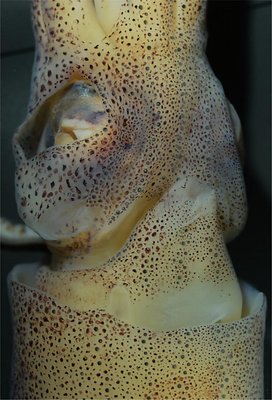
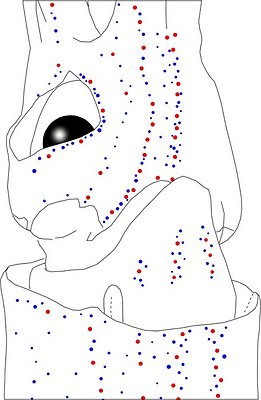
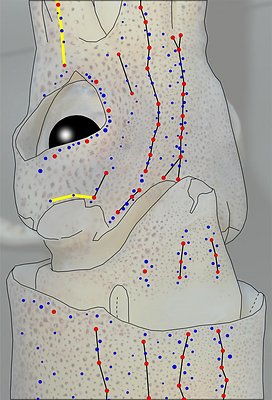
Figure. Oblique view of the head region of Abraliopsis sp. NC1, female, 28 mm ML, larger specimen than above. Left - Photograph of the preserved squid. Middle - Outline drawing from photograph with all integumental photophores represented by colored dots. Right - Outline drawing over dimmed photograph with all integumental photophores represented by colored dots, and with lines connecting some photophores. Red dots - Complex photophores. Blue dots - Non-complex photophores. Lines connecting photophores assist in understanding the organization of the photophores. Black lines - Patterns based on red photophores. Yellow line - Pattern based on red and blue photophores. Images by R. Young.

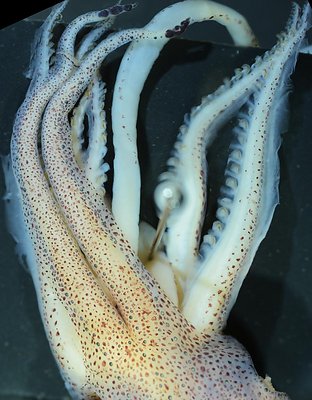
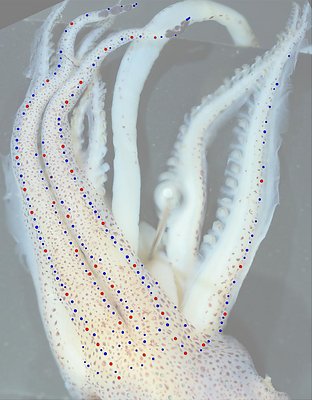
Figure. Ventral view of the integumental photophores of arms III and IV of Abraliopsis sp. NCI, female, 26 mm ML. Left - Photograph of the preserved squid. Right - Photograph dimmed with all integumental photophores represented by colored dots. Red dots - Complex photophores. Blue dots - Non-complex photophores. Images by R. Young.

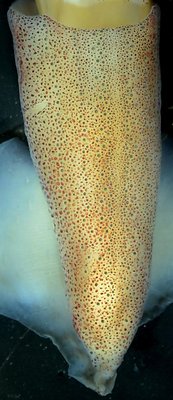
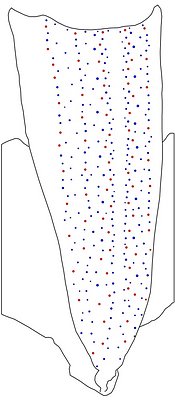
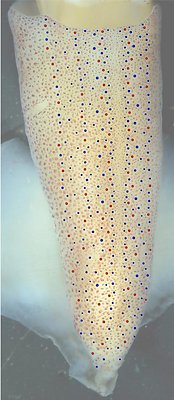
Figure. Ventral views of the mantle photophores of Abraliopsis sp. NC1, mature female, 26 mm ML. Left - Photograph of the preserved squid. Middle - Outline drawing from photograph with all integumental photophores represented by colored dots. Right - Photograph (dimmed) with colored dots superimposed on integumental photophores. Red dots - Complex photophores. Blue dots - Non-complex photophores. Images by R. Young.

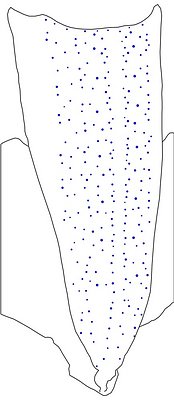
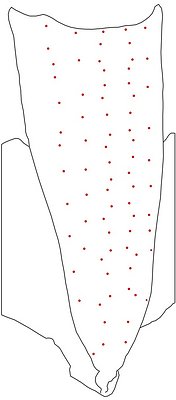
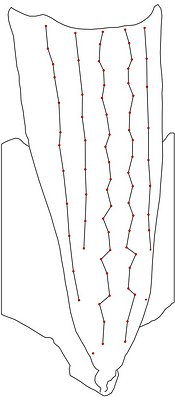

Figure. Same view, same squid. Left - Drawing showing only the non-complex (blue) photophores. Left-middle - Drawing showing only the complex (red) photophores. Right-middle - Same drawing with lines connecting red photophores to aid comparisons of photophore patterns between species. Right - Drawing showing all photophores and lines showing red photophore patterns. Images by R. Young.
Table. Ventral view of the funnel-groove region of A. morisii. Top tier - Photograph of the preserved squid showing photophores of the funnel groove and surrounding tissue. Middle tier - In the photograph, white dots are placed over the "white" photophores of the funnel groove. Black dots are placed over the two most posteromedial "red" photophores of the ventral head to mark the anterolateral edges of the funnel groove. Bottom tier - Same pattern of dots as in photographs but dots are colored. Colored dots, lines - Aid in comparison of patterns between species. Open dots - Represent photophores that are either of uncertain status as "white" photophores or have variable presence. Images by R. Young. Comparison of white photophore patterns for all Abraliopsis species can be found here.
| Mature male, 20 mm ML | Mature female, 26 mm ML | Mature female, 28 mm ML |
|---|---|---|
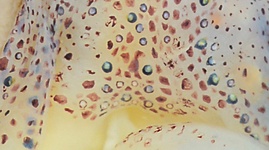 | ;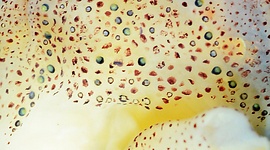 | 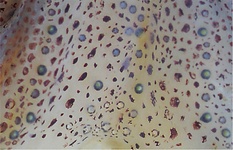 |
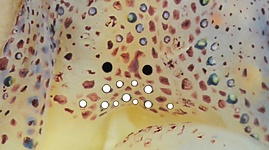 | 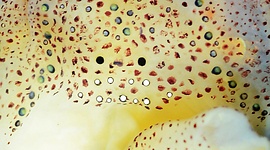 | 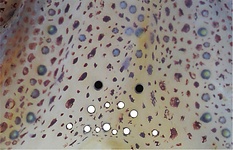 |
 | 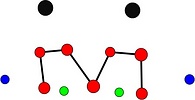 | 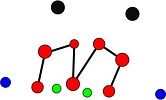 |
Comments: Summary of photophore distributions.(photophore definitions found here)
ARMS:
Medial Arm IV Series - Continuous; reaches about 70% of the ML. Blue photophores show a tendency to lie in a single line.
Central Arm IV Sector - Few blue photophores present at proximal end.
Lateral Arm IV Series - Slightly discontinuous near arm tip; reaches the arm tip. Blue photophores show a tendency to lie in a single line..
Lateral Membrane Series of arms IV - Reaches about 20% of arm length.
Arm III Series - Slightly discontinuous (= irregular alignment); virtually reaches to arm tip (~90% of arm length).
HEAD - Typical 3 photophore series on central-ventral head with:
Median Head Series - 3 "red" photophores in posterior caret; anteriorly, somewhat irregular single series.
Median Head Sector - Absent.
Lateral Head Sector - Numerous "blue photophores scattered centrally from arm IV base to edge of funnel groove with fewer photophores laterally.
Window Sector - Very few anterolateral blue photophores. Otherwise, photophores absent.
1st Lateral Window Series - Two segments broadly separated by single series of blue photophores: Both segments with 2 red photophores.
2nd Lateral Window Series - Absent.
Eyelid Series - Eyelid with red photophores only on ventral half. Posterior Eyelid Series with two large blue photophores displaced slightly posteriorly from eyelid series; more ventral of two, larger and more posterior. Formula: RbbBB.
Occipital Series - Rbb.
Lateral Funnel-groove Series - 3 (1+2) red photophores.
White Patch (funnel groove) - Complex-1 Pattern (red, green, blue).
FUNNEL:
Medial Patch - Straight series of 3 red photophores.
Lateral Patch - One red photophore.
MANTLE - Typical 3 photophore series on ventral mantle with:
Median Mantle sector - Narrow, without photophores in central region over entire mantle length; blue photophores few and loosely positioned mostly along medial margin.
Medial Mantle Series - Irregular single series.
Lateral Mantle Sectors - In anterior half of mantle, few blue photophores (fewer in 2nd Sector), all scattered.
Lateral and Mantle-angle series - Both with virtually straight alignment (alignment anteriorly veers laterally as mantle broadens).
Comment-2
The NC species were frozen prior to fixation which makes detection of photophore types, arm membranes and trabeculae difficult and, probably, with more errors in description.




 Go to quick links
Go to quick search
Go to navigation for this section of the ToL site
Go to detailed links for the ToL site
Go to quick links
Go to quick search
Go to navigation for this section of the ToL site
Go to detailed links for the ToL site